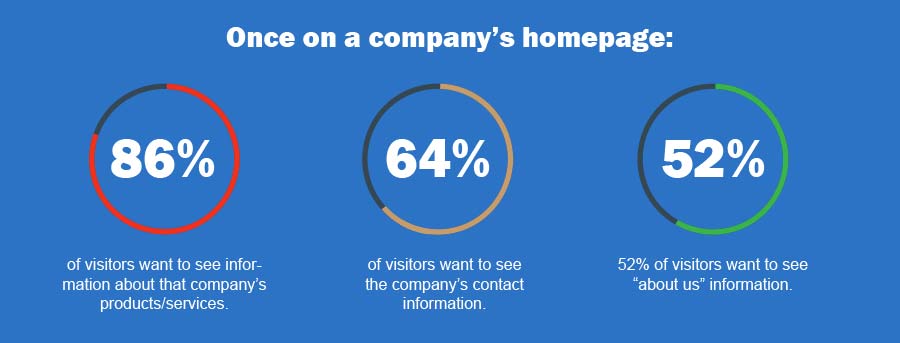Nowadays, people go online to do business, shop, plan a purchase, and more. This means that if you own a business, you need a website. And we don’t mean any old website. You need a GOOD website. A website that doesn’t make visitors run click away screaming. But, what are the characteristics of a successful website? That’s what we answer in this post. By the end, you’ll know what your website needs.
Nowadays, people go online to do business, shop, plan a purchase, and more. This means that if you own a business, you need a website. And we don’t mean any old website. You need a GOOD website. A website that doesn’t make visitors run click away screaming. But, what are the characteristics of a successful website? That’s what we answer in this post. By the end, you’ll know what your website needs.
Themes Successful Websites Have in Common
Figuring out the common themes of a successful website is the best way to learn what all good websites do well and what to avoid to ensure your website is successful. So, let’s look at some themes shared by first-rate websites.
Successful Websites Include the Must-Have Pages
Great websites always include the basic, must-have pages: a homepage, an about page, services and/or product pages, and a contact page. Beyond these pages, most great websites will also include: a testimonials page, FAQ page, and a blog. So, for a top-notch website you’ll need a minimum of four pages—a homepage, an about page, a products/services page, and a contact page.
Because people now go online before going to a store or business, your website is your chance to make a first impression. According to Google Reports, 50% of people conducting a local search online visit a store within 24 hours and 18% make a purchase. A quality website gives you a real chance to win customers, make new sales, and grow.
So, don’t be like the 26% of small business that only have a one-page site.1 Create a site with multiple pages and include the must-haves. Over time you can add pages to your site.
And if you’re wondering— having more than the must-have pages is okay. In fact, it’s advantageous for SEO. Just make sure each additional page is purposeful and on-brand. If you want to know how many more pages to have and what to include, it’s worth consulting with a professional for a custom recommendation based on your business goals.
Successful Websites Look Great
“Professional quality”—the two words that summarize this entire section.
Every brand is going to have a different vibe, but all great websites present their brand—their vibe—their look—their feel— you name it—professionally. They pay attention to the quality of their site, and they make sure it’s aesthetically pleasing because:
- 20% of your visitors will use web design as a reason to trust you (or not trust you)2
- 38% of your visitors will stop engaging with your site if its layout is unappealing3
- 48% of your visitors will use your website’s design to evaluate your credibility2
- 66% of your visitors prefer to read beautifully designed content, not plain looking content3
However, aesthetically pleasing doesn’t necessarily mean trendy. It may or may not be in your best interest to incorporate design trends. But, it is in your best interest to have a site that’s well laid out, professional-looking, and clean.
But, if you’re interested in what’s trending, some of this year’s top web design trends include:
- Animation
- Bold colors
- Unique typography
- Playful illustrations
- Asymmetric layouts
Other trends have business owners looking to include storytelling and AI.
Successful Websites Promote Their Social Media Presence
Great websites promote their business’s social media profiles by featuring social media share icons.
Each social media icon can be custom designed to match your brand colors and typography. Custom designing your icons is a great way to enhance the look and feel of your website.
Successful Websites Cover Their Bases
Of course, we’d be remiss if we didn’t mention the importance of a privacy statement. Even though few people will visit your site to read your privacy policy, great websites have one in place to cover their bases.
You’ll also want to comply with other rules and regulations that govern what you need to include on your website, and you’ll want to include any content that protects you or your business.
(We recommend you link to these pages in the footer of your website instead of listing each as a tab on your main navigation menu.)
Defining Your Website’s Success
Now that you know what all great websites have in common, it’s time to breakdown what each page should feature. In this post, we focus on what the must-have pages need to include to be successful.
Use this section of the post as a checklist when creating your website to ensure your site has what it needs to succeed.
Home Page
Your homepage is where people land (usually) when they come to your site.
As one of your most trafficked sites, it needs to stand out. It needs to have the information people want and need to see to get them to click, convert, or engage. That information includes:
- A heading
- A subheading
- Primary and secondary calls to action
- Images and/or videos
- A summary of what you do and offer (high-level summary of key benefits and features)
- Social proof (e.g., small testimonial or picture)
- Navigation menu (should be easy to find at top of page)
- An enticing offer
In other words, your home page should quickly explain who you are, what you do, what you offer, where to find what you offer, how to contact you, and why prospects should buy/download/call/email etc.
In general, your homepage is a summary of your entire site.
About Page
Your about page may receive the most traffic, so make it good! People expect about pages to include variations of the following:
- Company history
- Team bios
- Your Company USP—Why You’re Different
- Your Company Philosophy
- Client list (if it’s impressive)
- Testimonials
- Press
You’ll use your about page to give an overview of your company’s history to help visitors get to know your brand and employees. If done right, an about page will build trust and authority—two commodities you’ll need if you hope to convert prospects.
Services and Capabilities Pages
Nearly all visitors will look at your services or product pages. On these pages, your goal is to educate visitors about what you offer, anticipate and answer their questions, and explain the benefits and features of your services and products.
These pages are easier to navigate when each service or product has its own page or space. Use bullets and other icons to increase the scanability of these pages as most readers will skim through your site.
If your company is a full-service company, you’ll want to make that clear using a capabilities page. A capabilities page is where you showcase your expertise across multiple functions/platforms/processes etc.
Contact Page
We estimate that one out of every two people will click off a site because the contact page failed to provide contact information. Although you can include a general contact form, be sure to also include your business’s phone number, email address, and street address otherwise it looks like you’re hiding something, and people won’t trust you.
You may also want to include additional contact information such as your business hours and other ways to contact you (Skype, etc.)
Finally, weave contact information throughout your website. Include your full contact information in your website’s footer and your phone number and email at the very top of every page above your navigation bar.
Blog
About 70% of your consumers will learn about your company through your blog, not your ads.4 So include a blog on your website and update it as frequently as possible. The more posts you create, the better.
A Great Website Defines its Keys to Success from the Beginning
Now you know what it takes to create a first-rate, successful website. If designing websites isn’t your thing or you don’t think you can make one that looks professional, it’s worth hiring professionals to do it for you. With most everyone going online to buy, research, and plan, you can’t afford not to have a top-notch website. In fact, your business may depend on peoples’ impressions of your site. So do what it takes to make sure those impressions are favorable.
Sources:
- Web.com Small Business Digital Trends report
- https://www.tytonmedia.com/blog/51-insane-web-desi…
- https://blog.hubspot.com/marketing/compelling-stat…
- https://www.impactbnd.com/blog/statistics-website-…
Please contact Web Design Agency fishbat today for a free consultation.




